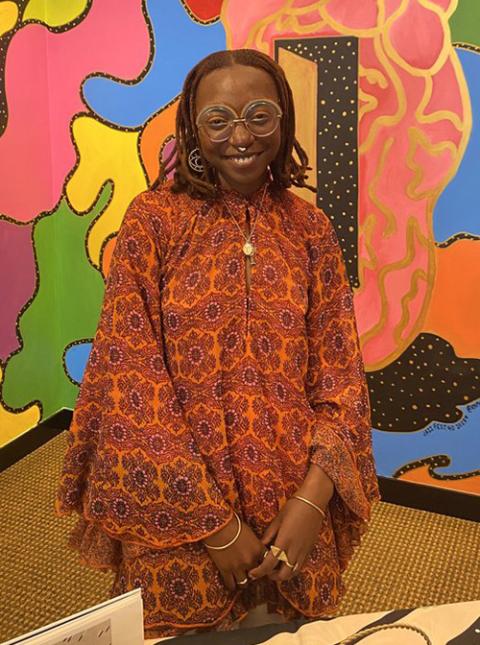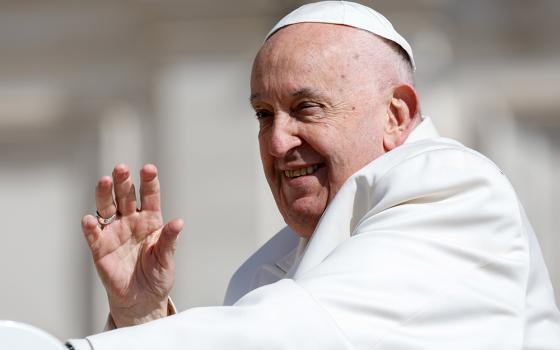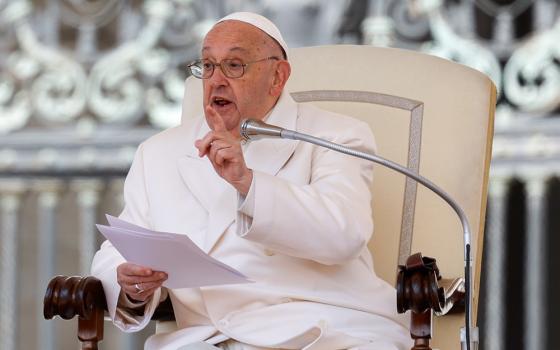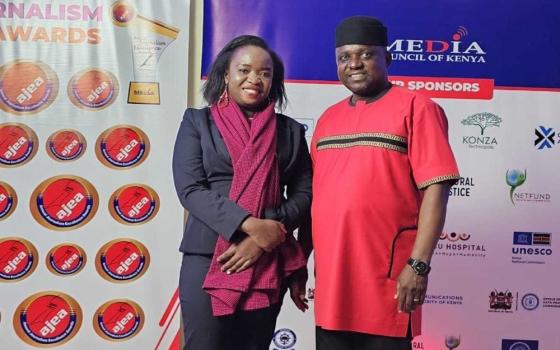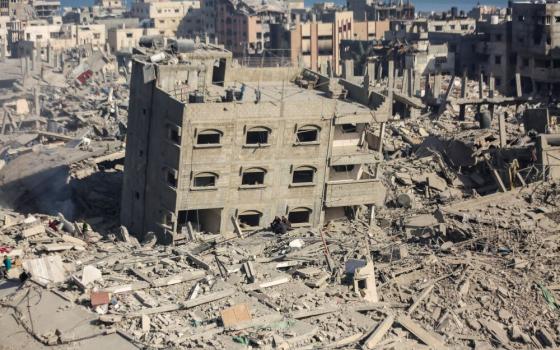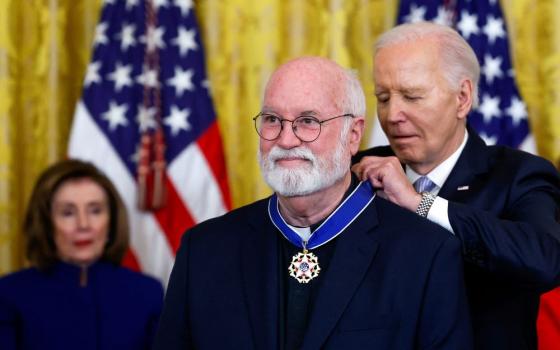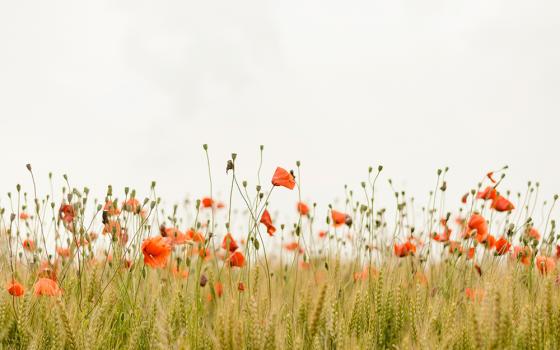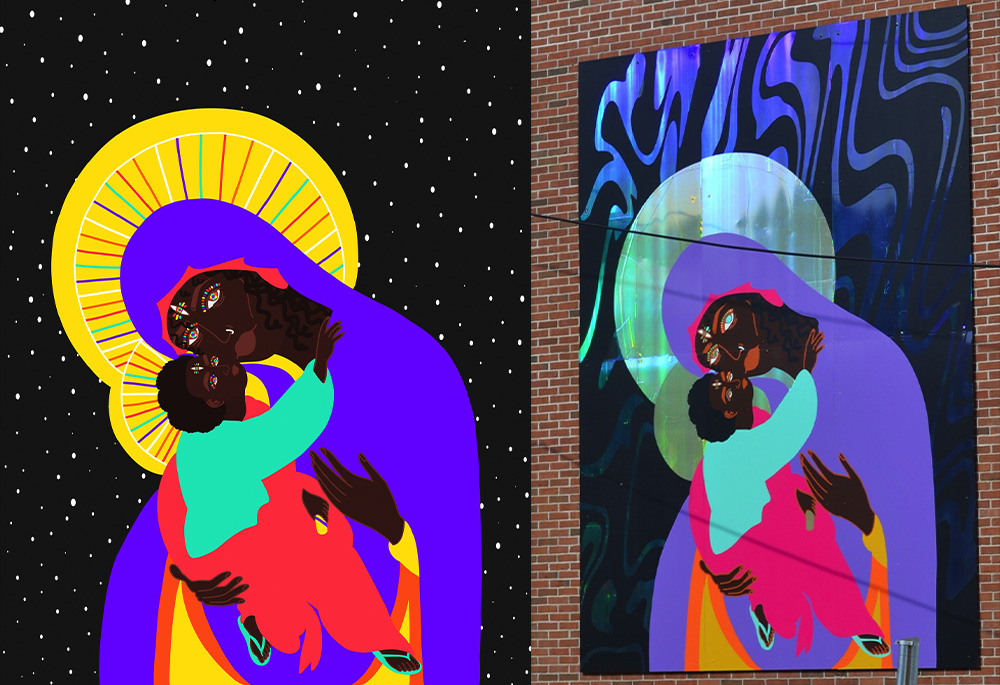
On the right is "Black Freedom, Black Madonna & the Black Child of Hope," original digital art by Raphaella Brice, and on the left is the Juneteenth mural of the piece on the south-facing exterior wall of the Fletcher Free Library in Burlington, Vermont. (Courtesy of Raphaella Brice)
On the side of the public library in the biggest city in the least religious state in the U.S., the Virgin Mary holds the infant Christ.
"Black Freedom, Black Madonna & the Black Child of Hope," a 16-by-12-foot mural on the south-facing exterior wall of the Fletcher Free Library in Burlington, Vermont, is the creation of Raphaella Brice, a 26-year-old Haitian American artist who is drawing deep from the font of her cultural identity and faith. In the process, she's injecting new spiritual energy into a state often imagined to be strictly secular.
According to Raphaella, her vocation started in the womb. By chance, her mother saw a documentary about the Renaissance artist Raphael on PBS. "She was fascinated by his story and named me Raphael. It was the hospital that added the 'la' at the end."
The name, meaning "God Heals," set the course for Raphaella's life. Her name goes all the way back to St. Raphael the Archangel, patron of travelers, and traveling is how she came into the world; she was born in 1997 on the side of a highway in West Palm Beach, Florida.
Raphaella grew up with artistic gifts that were slow to actualize. "I was always artistic but never applied myself to visual arts," she told NCR in an exclusive interview.
Travel helped sort that out. As an undergraduate at Manhattanville College, she did a year abroad in Belgium, studying at Leuven and writing for travel sites like Shut Up & Go and Intrepid Times. After graduating, she taught English in France, staying for almost a year. "It was a journey of self-discovery," she says, "the first time I really allowed myself to develop into my own person."
AmeriCorps brought her to Vermont, which started an important process of purification. "Coming to Vermont was a purging moment for me. Vermont is full of people running from something and finding themselves here. That began to happen for me."
Raphaella's new job in Vermont also created a seemingly chance encounter with an art studio. "I had a mentee that went to the Generator MakerSpace and I immediately felt the call to bring my digital pieces to life. Something inside me said this is who I am and what I need to be doing."
Raphaella had been making digital art since graduation, but now jumped all in, forging a style she calls "cultural psychedelic."
'I realized that we do all these things to be seen when in reality we just need to see ourselves. Doing that piece was a validation of who I am. I saw me.'
—Raphaella Brice
Purification evolved into a process of healing. She started a life of mindfulness and prayer with "lots of discipline, knowing that I needed to tend to my inner child. I had gotten pretty low, but I had this inner knowing that I was going to come back."
When the Burlington City Arts, in collaboration with the city's Office of Racial Equity, Inclusion and Belonging, put out a "call for artists" for the second annual Juneteenth BTV celebration April 2022, she was intrigued but didn't know what to depict, let alone if she could do a mural that portrayed her digital skills. A colleague suggested a Black Madonna to fit the theme of the Juneteenth celebration, "A Love Story."
The idea resonated with Raphaella for multiple reasons. She had a deeply Catholic childhood. Her Haitian family, like most Haitian families, is intensely spiritual. "We went to church all the time," she remembers. "I couldn't escape it."
The artist had an unexpected Catholic jolt in college. One Thanksgiving, her mother told her two siblings and father that they were going on a family vacation that year. It ended up being a silent retreat with the Divine Word order. "I was mad and still am till this day!" Raphaella laughs. "But it turned out being a good experience. It worked in my favor. The silence really helped me."
Mary had always been important in her family. Raphaella's mother had lost her own mother at age 12. "She cried for three straight months, then made the Virgin Mary her mother."
Advertisement
The Black Madonna also made herself the mother of Haiti. Known in Haiti as the Vodoun lwa Erzulie Dantor and the Catholic Our Lady of Czestochowa, the Black Madonna was a revolutionary spiritual force in the country. "This spirituality — the fusion of African spirituality and Catholicism — literally freed my ancestors from the French colonizers."
Raphaella submitted her proposal for "Black Freedom, Black Madonna & the Black Child of Hope" and heard right away of her acceptance. She jumped in, learning the medium on the fly. It took one month and the result was the 16-by-12-foot mural that now adorns the side of the library.
It wasn't until Raphaella finished the mural that the significance of the piece and its healing properties came to life. When the mural went up on June 15, 2022, two circular rainbows appeared above it. When she went to her car, she rediscovered a holy card of Our Lady of Czestochowa on the dashboard that her mother had given her when she first moved to Vermont.
Raphaella took these signs as affirmations of her work. "The universe knew that this was what I needed to do. I realized that we do all these things to be seen when in reality we just need to see ourselves. Doing that piece was a validation of who I am. I saw me."
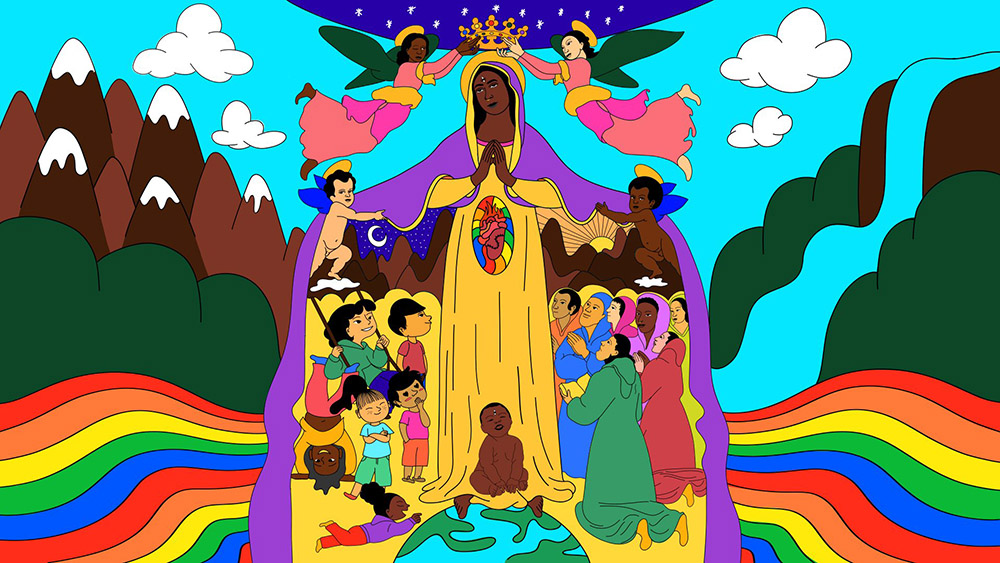
"Madonna's Earth" original vector illustration by Haitian American artist Raphaella Brice (Courtesy of Raphaella Brice)
The response in Vermont has been broad and positive. Raphaella has been featured by the local papers Burlington Free Press and Seven Days. Her work was on the cover of the summer issue of the Vermont Catholic. And a new Black Madonna mural went up in Waterbury, a town in central Vermont, one of the communities affected by the July 2023 flooding.
The Waterbury Area Anti-Racism Coalition sponsored the Waterbury Community Mural Project and chose Raphaella's piece to publicly embody its vision "to create a community where every person can fully experience freedom, belonging, and love on a daily basis."
"Madonna's Earth" was installed in Waterbury Sept. 30, and adds a new communal dimension within it. The Mother emerges from the Earth gathering the global family in her loving embrace, further embodying the inclusive spiritual space that Raphaella's work opens up, blurring the artificial religious vs. secular divide.
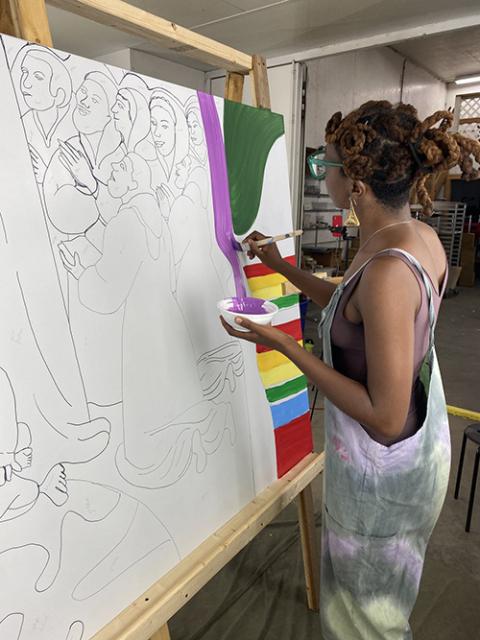
Raphaella Brice takes part in painting the Waterbury Area Anti-Racism Coalition community mural of her digital art "Madonna's Earth" in Waterbury, Vermont. (Courtesy of raphdraws.com)
Nonreligious people can be open — even attracted — to Catholic spirituality that they perceive to be untethered to what triggers them about the church.
Meanwhile, Catholics recognize the roots of Raphaella's art, and the prominence of her murals in public spaces function as a welcome nod of acceptance for people of faith who often feel excluded from or judged by secular society.
Raphaella's art also bridges racial divisions, as the Virgin Mary is part of a global tradition. At the same time, Marian spirituality is an often unseen part of the Black experience in North America and a liberative force, whether in the Haitian Revolution or in the 1837 Stono Rebellion of South Carolina, when enslaved peoples of the Kingdom of Kongo rose up on the feast of the Nativity of Mary.
When I asked Raphaella about her name, its layers of meaning and connections to her work, she answered with the kind of authenticity that has made her work so publicly accessible. "I always knew the origin story and its meanings, but it wasn't until I started creating art in Vermont that I circled back. It still seems so weird, so seemingly random," she said.
"Yet the connections make me believe in the Catholic world even more. I often resented it; there's plenty of perils growing up in a religious context, where everything is defined as very good and very bad. But it's in that world where the spiritual and human intertwine and we see life is a spiral, we are constantly refining ourselves."
That sounds like healing to me.





